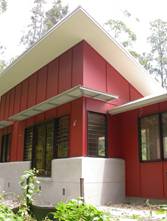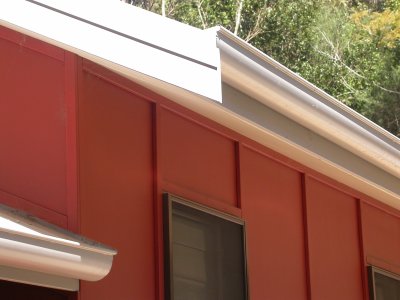Definition
Fibre cement is a composite building material made of sand, cement and cellulose fibres. Fibre cement cladding comes in various forms but is often seen in horizontal boards, imitating wooden clapboard and in sheet form. Other formats include imitation shingles. Fibre cement sheeting can be used to cover the exterior of a house and can also be used as a substitute for timber fascias and barge boards in high fire danger areas. It is also commonly applied as a tile underlay on decks and in bathrooms. Fibre cement sheeting is easy to secure and maintain as a soffit/eave lining.
Examples of Fibre Cement Cladding
 |
=> |  |
FC Sheeting Specifications
Fibre cement sheeting products are manufacture by CSR, BGC and James Hardie in accordance to with AS2908.2000 Cellulose Cement Products, and include such products as Matrix, ExoTec and Villaboard. FC sheet sizes vary slightly from manufacture to manufacture but generally they range between 2400 - 3000mm in length and 900 - 1200mm in width (600 & 450mm increments) This manufactured size minimises on-site wastage as residential floor, wall and roof structures lay structural members at 450 or 600 centres. Fibre cement thicknesses vary between 4.5 - 18mm and also vary in density - the lower density resulting in a fibrous rough edge when cut and the higher density having a cleaner smoother edge when cut. Thermal resistance and sound transmission vary great between fibre cement products. Fibre cement sheet products rate poorly in thermal resistance and sound transmission and separate wall insulation is highly recommended. Generally the thicker and more dense the product the better resistance it will have to temperature and sound transmission.
Construction techniques
Fibre cement sheets are usually delivered on-site by truck but on properties with difficult access - for example steep waterfront properties the product is often delivered by water barge then craned onto site. Fibre cement sheeting is a very heavy product and requires 2 men to carry the uncut sheets to their cutting location. Once the product is cut it requires again 2 men to install - one to hold the sheet flush against studwork and the other to nail the product in place. Once the product is fixed the joins are covered with timber battens and the entire wall surface is painted. FC sheets can be cut to size in three ways:
- Thinner sheets can be scored with a heavy duty cutting blade and snapped
- Purpose made Fibro cutter
- Thicker and more dense sheets require cutting by a mechanical saw
Alternatives
Alternatives to fibre cement cladding include vinyl/PVC, wood and wood composite products and aluminum. Advantages of vinyl include the fact that it has a lower material cost and is easier to transport than fibre cement cladding due to its lighter weight and its pliability. Vinyl siding, however, is more susceptible to fire damage (or melting under extreme temperatures) than fibre cement cladding, and can become brittle in cold weather or from long-term solar exposure. Fibre cement cladding primary advantage over wooden siding is its lack of susceptibility to termites or rot.
History
Fibre cement products come about as a replacement for the widely used "Asbestos Cement Sheeting" product manufactured by "James Hardie" in the 1980's.
Further reading
- A history of James Hardie and fibre cement building products
- Wikipedia: Fiber cement siding
- If fibre cement sheeting is not for you, here is an article that discusses various other types of cladding: Funky Claddings
